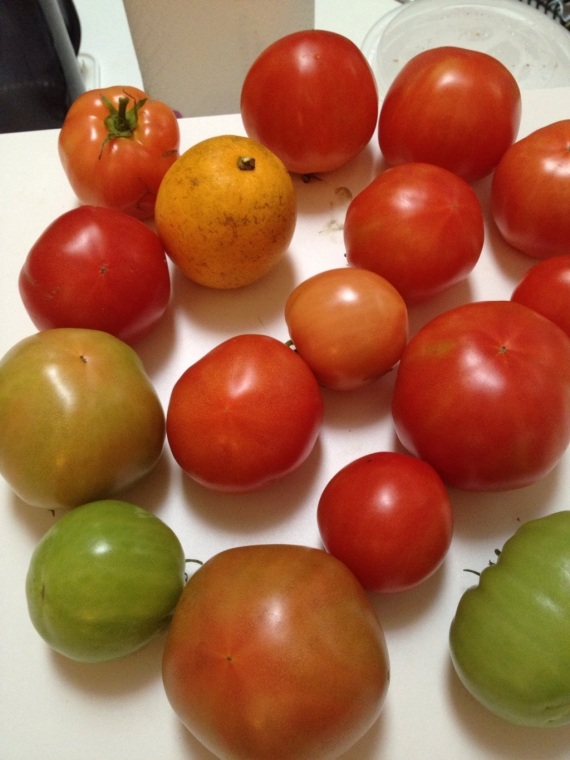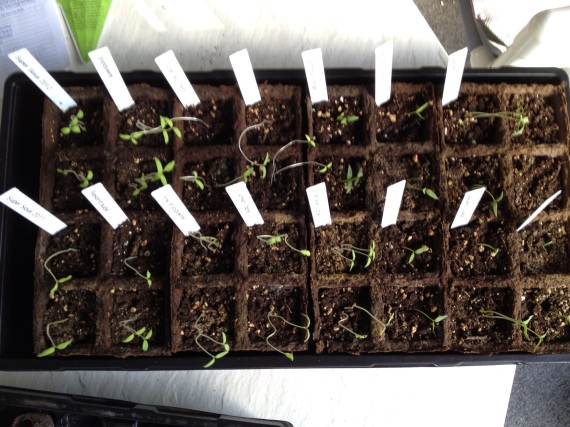
The calendar still says “Spring” for a few more hours, but that hasn’t stopped me from starting my fall garden. In fact, I started it a couple weeks ago by planting some tomato seeds and pepper seeds in a starter tray. All of them have sprouted now, with the exception of one variety which I ordered later than the others and only planted this morning. Assuming they do well, the tomato and pepper section of my garden will resemble a sampler platter this fall; I have two plants each of ten tomato varieties and six pepper varieties, each of which has its own story. To be precise, I might only have nine varieties of tomatoes, in which case I will have four plants of one kind, as you will understand shortly.
I describe each of these varieties below, and indicate where I got each one. To assist any interested readers in obtaining the same varieties, where links are available, I link the respective organization names below to the pages where these seeds can be ordered.
Pepper Varieties:
- Black Hungarian — I have not yet found a good source of history for this pepper, but I have found lots of descriptive information. It seems this variety is planted as much for its ornamental characteristics as for its flavor, which has a wide range of Scoville (hotness) ratings — anywhere from 2500 at the low end to about 50,000. The plant is supposed to be very pretty, with emerald leaves accented by purple veins. The flowers are a deep purple, and the peppers, which are shaped like a jalapeño, start out green, turn black, and then ripen to red. This is my first time growing this variety. I bought the seeds from
Seed Savers Exchange. - Fish — This variety has a very interesting heritage involving fish houses, bee stings, and African American history. The fish pepper carries the same recessive gene that causes albinism in other species, and produces an assortment of red, white, and red and white striped pods. The seeds for this variety were donated to Seed Savers Exchange by William Woys Weaver, who got the seeds from his grandfather. His grandfather had received them from a black folk painter by the name of Horace Pippin. According to Mr. Pippin, these peppers were a secret heirloom variety used by the black caterers in Baltimore fish houses, where the white pods were used to make white paprika that went into cream sauces and soups. A good article by Mr. Weaver about the fish pepper can be found at this link in the Mother Earth News. This article also includes a recipe for White Hot Fish Pepper Salsa. I bought mine from Seed Savers Exchange.
- Jalapeño M — Jalapeño peppers are well known and widely grown, though the history is somewhat obscure. They are a moderate to hot type of pepper, with Scoville ratings anywhere from 5,000 to about 30,000 units. The Jalapeño M variety is on the hotter side, and are often used in making nachos. I purchased mine from a farmers cooperative called Southern States.
- Jalapeño Traveler’s Strain — This variety of jalapeño was donated to Seed Savers Exchange by an SSE member by the name of Larry Pierce. He called them a traveler’s strain because he carried the seeds with him on several moves around the country, including Oklahoma, Wyoming, and Missouri.
- Long Red Cayenne — Cayenne is another well-known hot pepper. This variety has long, slender pods (about 5 inches long and a quarter inch across). Their Scoville rating is in the 30K to 50K range. I obtained these from Southern States.
- Sweet California Wonder — This is a classic heirloom bell pepper, introduced in 1928. It can be eaten green or allowed to ripen to red. The peppers are typically 3 to 4 inches each. I also have some growing in my spring/summer garden; they are days away from being ready to pick. I purchased them from Burpee.
Tomato Varieties:
- Amish Paste — This variety was first obtained from the Amish near Lancaster, Pennsylvania and was then commercialized by Tom Hauch. I obtained mine from Seed Savers Exchange. The fruits are good for eating or making sauce. The bright red fruits weigh in at 8 to 12 ounces and can be oxheart-shaped or more like a rounded plum. This tomato is included in Slow Food USA’s Ark of Taste.
- Brandywine — Yet another Seed Savers Exchange purchase for me, this variety is the one that SSE calls a Brandywine or Red Brandywine. There seem to be as many varieties called Brandywine as there are purported histories. A common theme is that they came from the general region of Ohio or Pennsylvania. Regardless which might be the “real” Brandywine, the Brandywines are very popular and highly regarded for their flavor. This one, according to SSE, produces 1 pound red beefsteak fruits. I have some of these in my spring/summer garden as well.
- Brandywine (Suddath’s Strain) — This strain, also from Seed Savers Exchange, produces 1 to 2 pound pink beefsteaks. According to SSE, this variety was grown for over 100 years as a Brandywine by a family named Suddath, hence the name. This variety is currently growing in my spring/summer garden and is also included in the Slow Food USA Ark of Taste.
- Cherokee Purple — This variety has only been available to the general public for about twenty years, but it has quickly gained in popularity because of its exceptional taste. It is believed to have been grown by the Cherokee people over a hundred years ago. The fruits average about a pound and have the typical shape of a beefsteak. Their color pattern sets them apart; they have red skin with green shoulders and a deep purple hue to the meat. When sliced, the purple is emphasized by the green gel that usually surrounds the seeds. I bought mine from the Victory Seed Company.
- Large Red Cherry — The name pretty much says it all. This is an old variety that produces a prolific harvest of red fruits measuring 1-1/2 to 2 inches each. I obtained mine as a “thank you” gift from Seed Savers Exchange when I became a member of the organization.
- Lemon Drop — This variety was discovered by J. T. Sessions of Florida, when he found it growing among a crop of white cherry plants. It produces a lot of 1/2 to 3/4 inch translucent yellow-green tomatoes, and is said to keep producing even in cold, wet weather. It won the 2010 SSE Tomato Tasting award. I obtained mine from Seed Savers Exchange.
- Riesentraube — The name of this German variety translates roughly as “giant bunches of grapes.” The fruits are red and about an inch each. I have some of these growing in my spring/summer garden as well. As with many others, I got them from Seed Savers Exchange.
- Super Sioux — The Sioux tomato was released by the University of Nebraska in 1944. The Super Sioux was developed from that strain to increase the size of the fruits and to improve disease resistance. It is known for its ability to produce in a wide range of weather conditions, including hot and dry weather. Once it starts producing, it continues until the first frost. This was my best producer last season. The fruits were red and very tasty, although highly variable in size. I obtained these seeds by saving the seeds from some tomatoes grown by my stepson in Tallahassee, who was growing this variety exclusively last summer.
- Super Sioux 2012 — Because I had such a good harvest last season, I decided to save some of the seeds from that harvest. However, since I did not take any precautions to isolate them from the other two varieties I grew at that time, I cannot be sure that the seeds are pure until I see how they produce. For ow, I’m referring to these seeds as Super Sioux 2012, just to keep them apart from the previous year’s seeds, which I know to be true representatives of that variety.
- Vinson Watts — The last variety in this alphabetical list was also the last variety that I planted for this round, but is at the top of my “I can hardly wait” list. Vinson Watts, an Associate Dean at Berea College, was known to his friends and neighbors as the “Mater Man” because of his expertise and tirelessness at growing tomatoes. In 1956, his supervisor at Berea gave him some tomato seeds from some stock originally from Lee County, Virginia, the westernmost county in Virginia, wedged in between Kentucky and Tennessee. For the next 52 years, Watts selected the best tomatoes from this strain and saved the seeds. Over the years, a new variety emerged, which now bears his name. In 2007, he was given a Lifetime Achievement Award for Sustainable Agriculture from the Sustainable Mountain Agriculture Center, also of Berea. He passed away in 2008. The seeds I have are from a special order stock available from the Sustainable Mountain Agriculture Center. These seeds are from plants grown from original seeds grown and gathered by Mr. Watts himself before his death.
Note: for those who are interested, this is the same organization from which I bought my Nickell Beans, as discussed in my recent blog posting, Carrying Moonbeans Home in a Jar.
As I have mentioned in previous blog posts, I am still learning how best to garden in Zone 9. I find it quite remarkable how little information there is regarding when to start fall plantings in this region. Last year I started my tomatoes and peppers the first week of August and found that to be somewhat late. My first tomatoes ripened around New Year’s Day, and my peppers did not make it at all. If we had had an early frost, I probably would not have gotten tomatoes either. On the other hand, we enjoyed a steady supply of tomatoes well into spring. For this year, my reasoning is that an early June start should yield tomatoes in the October/November timeframe.


Posted by Skip Slone on June 20, 2012 at 5:44 pm
By the way, did anyone happen to notice that one of the “tomatoes” in the first picture was not a tomato? That was a picture I took last winter, and everything in the picture was picked on the same day. I had previously posted this picture elsewhere with the caption, “One of these things is not like the others” — just for fun.